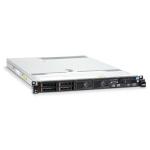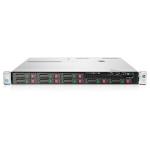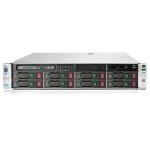Description
The IBM System x3650 M4 server provides outstanding performance for your business-critical applications. Its energy-efficient design supports more cores, memory, and data capacity in a scalable 2U package that is easy to service and manage. With more computing power per watt and the latest Intel Xeon processors, you can reduce costs while maintaining speed and availability.
Suggested use: database, virtualization, enterprise applications, collaboration/email, streaming media, web, HPC, Microsoft RemoteFX, and cloud applications.
Did you know?
The x3650 M4 offers a flexible, scalable design and simple upgrade path to 16 hard-disk drives (HDDs) or solid-state drives (SSDs) plus optical and tape drives at the same time, with up to six PCIe Gen 3 slots and up to 768 GB of memory. This flexible onboard Ethernet solution provides four standard embedded Gigabit Ethernet ports and two optional embedded 10 Gb Ethernet ports without occupying PCIe slots. Comprehensive systems management tools with the next-generation Integrated Management Module II (IMM2) make it easy to deploy, integrate, service, and manage.
Key features
The x3650 M4 is an outstanding 2U two-socket business-critical server, offering improved performance and pay-as-you grow flexibility along with new features that improve server management capability. This powerful system is designed for your most important business applications and cloud deployments.
Combining balanced performance and flexibility, the x3650 M4 is a great choice for small and medium businesses up to the large enterprise. It can provide outstanding uptime to keep business-critical applications and cloud deployments running safely. Ease of use and comprehensive systems management tools make it easy to deploy. Outstanding RAS and high-efficiency design improve your business environment and help save operational costs.
Scalability and performance
The x3650 M4 offers numerous features to boost performance, improve scalability, and reduce costs:
– Intel Xeon processor E5-2600 product family improves productivity by offering superior system performance with 8-core processors and up to 2.9 GHz core speeds, up to 20 MB of L3 cache, and up to two 8 GT/s QPI interconnect links.
– Up to two processors, 16 cores, and 32 threads maximize the concurrent execution of multi-threaded applications.
– Intelligent and adaptive system performance with Intel Turbo Boost Technology 2.0 allows CPU cores to run at maximum speeds during peak workloads by temporarily going beyond processor TDP.
– Intel Hyper-Threading Technology boosts performance for multi-threaded applications by enabling simultaneous multi-threading within each processor core, up to two threads per core.
– Intel Virtualization Technology integrates hardware-level virtualization hooks that allow operating system vendors to better utilize the hardware for virtualization workloads.
– Intel Advanced Vector Extensions (AVT) significantly improve floating-point performance for compute-intensive technical and scientific applications compared to Intel Xeon 5600 series processors.
– Twenty-four Load Reduced DIMMs (LRDIMMs) of 1333 MHz DDR3 ECC memory provide speed, high availability, and a memory capacity of up to 768 GB (running at 1066 MHz).
– Theoretical maximum memory bandwidth of the Intel Xeon processor E5 family is 51.6 GB/s, which is 60% more than in the previous generation of Intel Xeon processors.
– The use of solid-state drives (SSDs) instead of, or along with, traditional spinning drives (HDDs) can significantly improve I/O performance. An SSD can support up to 100 times more I/O operations per second (IOPS) than a typical HDD.
– Up to 16 drive bays, together with internal backup and an optical drive at the same time, provide a flexible and scalable all-in-one platform to meet your increasing demands.
– The server has four integrated Gigabit Ethernet ports and two optional 10 Gb Ethernet ports with mezzanine cards that do not consume PICe slots.
– The server offers PCI Express 3.0 I/O expansion capabilities that improve the theoretical maximum bandwidth by 60% (8 GT/s per link) compared to the previous generation of PCI Express 2.0.
– With Intel Integrated I/O Technology, the PCI Express 3.0 controller is integrated into the Intel Xeon processor E5 family. This integration helps to dramatically reduce I/O latency and increase overall system performance.
Availability and serviceability
The x3650 M4 provides many features to simplify serviceability and increase system uptime:
– The server offers memory mirroring and memory rank sparing for redundancy in the event of a non-correctable memory failure.
– Tool-less cover removal provides easy access to upgrades and serviceable parts, such as CPU, memory, and adapter cards.
– The server offers hot-swap drives, supporting RAID redundancy for data protection and greater system uptime.
– The server has up to two redundant hot-swap power supplies and four hot-swap dual-motor N+N redundant fans to provide availability for business-critical applications.
– The power source independent light path diagnostics panel and individual light path LEDs quickly lead the technician to failed (or failing) components, which simplifies servicing, speeds up problem resolution, and helps improve system availability.
– Predictive Failure Analysis (PFA) detects when system components (processors, VRMs, memory, HDDs, fans, and power supplies) operate outside of standard thresholds and generates proactive alerts in advance of a possible failure, therefore increasing uptime.
– Solid-state drives (SSDs) offer significantly better reliability than traditional mechanical HDDs for greater uptime.
– Built-in Integrated Management Module Version II (IMM2) continuously monitors system parameters, triggers alerts, and performs recovering acti




